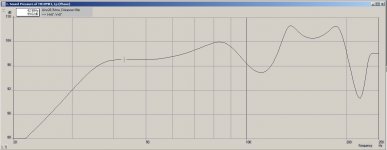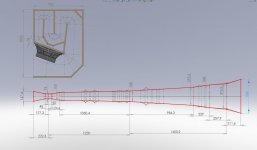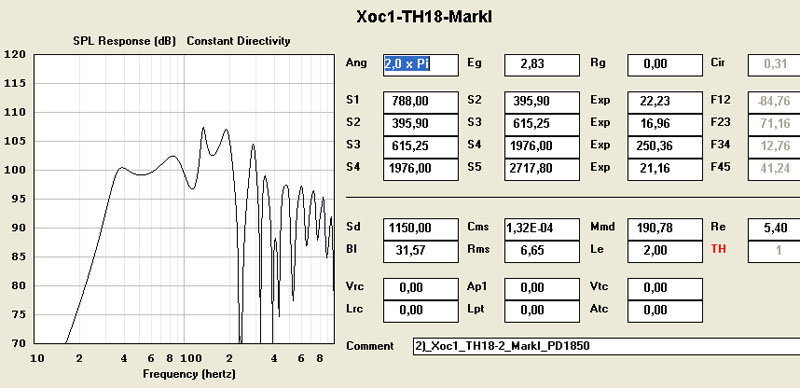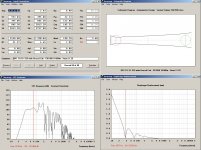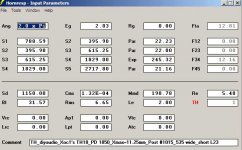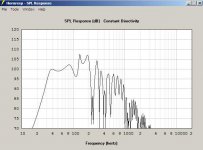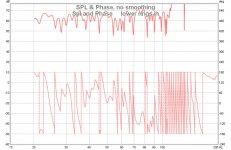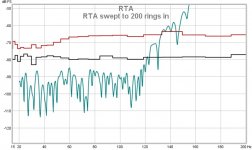Hi again,
And just because it was so much fun, here is a simple cone correction using 1/2" discs (it may be worthwhile to do the math, as every box is different, and every speaker is different too [and your math may be better than mine] ), at least this is one board that doesn't need additional bracing (?):
), at least this is one board that doesn't need additional bracing (?):
Regards,
And just because it was so much fun, here is a simple cone correction using 1/2" discs (it may be worthwhile to do the math, as every box is different, and every speaker is different too [and your math may be better than mine]
Regards,
Attachments
Hi Oliver,
Interesting ,so do you think in the case of using a 18 " speaker that the disks would react differently as apposed to the stub that goes across the whole camber or if the stub was shorter what difference in responce would that have,
To all of you guys Nice work on cone corrections ,I am beginning to figure it out ,Got REW setup and working just got to get the hows and whys to correctly figured, to hopefully have a correct response curve,!
Have A GREAT Day!
ns
Interesting ,so do you think in the case of using a 18 " speaker that the disks would react differently as apposed to the stub that goes across the whole camber or if the stub was shorter what difference in responce would that have,
To all of you guys Nice work on cone corrections ,I am beginning to figure it out ,Got REW setup and working just got to get the hows and whys to correctly figured, to hopefully have a correct response curve,!
Have A GREAT Day!
ns
Hi noSmoking,
Post #1002: "...do you think in the case of using a 18 " speaker that the disks would react differently as apposed to the stub that goes across the whole camber or if the stub was shorter what difference in responce would that have..."
If you are refering to the examples I posted in Posts #997 and 1001, I think that the results would be quite similar; they are both examples of "simple cone correction".
What Sergey (grec13) indicated in Post #992, and Art (weltersys) pointed out in Post #996 is that there is a difference between what could be called a "V" throat and simple cone correction. Art already gave the reference to Post #528, in Post #546 Djim shows the basic cone volume corrections for both driver sides (you are really looking at correcting volumes as Djim has by now amply demonstrated), then in Post #562 Martin (Xoc1) shows a basic outline for updating the TH18 (and cross-references to the other thread), and it goes on and on, sadly the picture Djim posted in #841 has been removed, but the following discussion pretty much clarifies what is going on, and how important the design integration between driver and enclosure has become in the tapped horn. Anyway, I'm rambling, this is really a remarkable thread, and it's so worth reading carefully. Your measurements of your enclosure with the throat treatment from Post #938 should add to the data, just guessing I would say that you are somewhere between simple cone correction and "V" throat.
Regards,
Post #1002: "...do you think in the case of using a 18 " speaker that the disks would react differently as apposed to the stub that goes across the whole camber or if the stub was shorter what difference in responce would that have..."
If you are refering to the examples I posted in Posts #997 and 1001, I think that the results would be quite similar; they are both examples of "simple cone correction".
What Sergey (grec13) indicated in Post #992, and Art (weltersys) pointed out in Post #996 is that there is a difference between what could be called a "V" throat and simple cone correction. Art already gave the reference to Post #528, in Post #546 Djim shows the basic cone volume corrections for both driver sides (you are really looking at correcting volumes as Djim has by now amply demonstrated), then in Post #562 Martin (Xoc1) shows a basic outline for updating the TH18 (and cross-references to the other thread), and it goes on and on, sadly the picture Djim posted in #841 has been removed, but the following discussion pretty much clarifies what is going on, and how important the design integration between driver and enclosure has become in the tapped horn. Anyway, I'm rambling, this is really a remarkable thread, and it's so worth reading carefully. Your measurements of your enclosure with the throat treatment from Post #938 should add to the data, just guessing I would say that you are somewhere between simple cone correction and "V" throat.
Regards,
Hi Oliver,
Well put, I have studied and read all those threads and other info ,I now have a very good Idea of horn corrections to implement in to the camber now,I will do some tests and see what I can get them to do,LOL.
Thanks all of you for your time and help!
NoSmoking
Well put, I have studied and read all those threads and other info ,I now have a very good Idea of horn corrections to implement in to the camber now,I will do some tests and see what I can get them to do,LOL.
Thanks all of you for your time and help!
NoSmoking
Oliver, thank you for clarification.
Hi noSmoking,
Post #1002: "...do you think in the case of using a 18 " speaker that the disks would react differently as apposed to the stub that goes across the whole camber or if the stub was shorter what difference in responce would that have..."
If you are refering to the examples I posted in Posts #997 and 1001, I think that the results would be quite similar; they are both examples of "simple cone correction".
What Sergey (grec13) indicated in Post #992, and Art (weltersys) pointed out in Post #996 is that there is a difference between what could be called a "V" throat and simple cone correction. Art already gave the reference to Post #528, in Post #546 Djim shows the basic cone volume corrections for both driver sides (you are really looking at correcting volumes as Djim has by now amply demonstrated), then in Post #562 Martin (Xoc1) shows a basic outline for updating the TH18 (and cross-references to the other thread), and it goes on and on, sadly the picture Djim posted in #841 has been removed, but the following discussion pretty much clarifies what is going on, and how important the design integration between driver and enclosure has become in the tapped horn. Anyway, I'm rambling, this is really a remarkable thread, and it's so worth reading carefully. Your measurements of your enclosure with the throat treatment from Post #938 should add to the data, just guessing I would say that you are somewhere between simple cone correction and "V" throat.
Regards,
Hi All
First post here and I'd like to start by just saying thanks to all for the contributions to this thread. Its been a fascinating progression to read and has almost convinced me to give the build a try with the latest "Xoc1" V throat additions.
I have three questions which Id greatly appreciate a response too:
1. Xoc1 are you planning on updating the original drawings to take "V throat" cone correction into account you illustrated in #990? I don't want to land up cutting and gluing only to find an updated cut sheet is on its way.
2.Is the Beyma 18SW1600ND a suitable driver for this design? http://profesional.beyma.com/pdf/18SW1600NdE.pdf Its the only drive I can source locally with similar specs to the B&C 18SW115.
3. Would 2 x TH18 loaded with the above Beyma driver powered by 1800 watt 4ohms/ch provide more output than 4 x SRX718 powered by the same amp? I have 2 x SRX718's and was about to buy a further two but I can pretty much build the TH18's for the price of two new 718's. The sensitivity of the JBL 2268HPL drive is rather poor though (95db) so I expect the Beyma driver (97db) to be a touch louder regardless of the Tapped Horn benefits.
Thanks again for this amazing thread!!
Getting quite excited to give this build a try and will be sure to post pictures of the build phases.
First post here and I'd like to start by just saying thanks to all for the contributions to this thread. Its been a fascinating progression to read and has almost convinced me to give the build a try with the latest "Xoc1" V throat additions.
I have three questions which Id greatly appreciate a response too:
1. Xoc1 are you planning on updating the original drawings to take "V throat" cone correction into account you illustrated in #990? I don't want to land up cutting and gluing only to find an updated cut sheet is on its way.
2.Is the Beyma 18SW1600ND a suitable driver for this design? http://profesional.beyma.com/pdf/18SW1600NdE.pdf Its the only drive I can source locally with similar specs to the B&C 18SW115.
3. Would 2 x TH18 loaded with the above Beyma driver powered by 1800 watt 4ohms/ch provide more output than 4 x SRX718 powered by the same amp? I have 2 x SRX718's and was about to buy a further two but I can pretty much build the TH18's for the price of two new 718's. The sensitivity of the JBL 2268HPL drive is rather poor though (95db) so I expect the Beyma driver (97db) to be a touch louder regardless of the Tapped Horn benefits.
Thanks again for this amazing thread!!
Getting quite excited to give this build a try and will be sure to post pictures of the build phases.
ARE WE THERE YET???

NOPE, the cook is still cooking.
Wait patiently for the final plans to be done.
NOPE, the cook is still cooking.
Wait patiently for the final plans to be done.
The Byema will work and the 2268H from the SRX718 will also work if the compression is lowered, S2=~600.Hi All
First post here and I'd like to start by just saying thanks to all for the contributions to this thread. Its been a fascinating progression to read and has almost convinced me to give the build a try with the latest "Xoc1" V throat additions.
I have three questions which Id greatly appreciate a response too:
1. Xoc1 are you planning on updating the original drawings to take "V throat" cone correction into account you illustrated in #990? I don't want to land up cutting and gluing only to find an updated cut sheet is on its way.
2.Is the Beyma 18SW1600ND a suitable driver for this design? http://profesional.beyma.com/pdf/18SW1600NdE.pdf Its the only drive I can source locally with similar specs to the B&C 18SW115.
3. Would 2 x TH18 loaded with the above Beyma driver powered by 1800 watt 4ohms/ch provide more output than 4 x SRX718 powered by the same amp? I have 2 x SRX718's and was about to buy a further two but I can pretty much build the TH18's for the price of two new 718's. The sensitivity of the JBL 2268HPL drive is rather poor though (95db) so I expect the Beyma driver (97db) to be a touch louder regardless of the Tapped Horn benefits.
Thanks again for this amazing thread!!
Getting quite excited to give this build a try and will be sure to post pictures of the build phases.
I have tried the 15HP1030 on an adapter plate, it works fine up to 1kw.I also have read this project and would like to use the Faital Pro 18" woofer can anyone recommend a neo 18" Faital for this project? Thanks!
The Byema will work and the 2268H from the SRX718 will also work if the compression is lowered, S2=~600.
Thinking about this, just build with the plans in the first post and load the 2268H. That should work out just fine.
Is this any good?
Maybe I need to sleep. I'm a bit concerned about the 110Hz dip to 96db
BTW this is still with the Precision devices PD1850.
Hopefully I haven't made any errors. Its close to the Hornresp response.
This version is slightly bigger by an inch front to back -
Think that's enough for today
Graph attached and text file for the akabak users to play with.
Regards
Martin (Xoc1)
Maybe I need to sleep. I'm a bit concerned about the 110Hz dip to 96db
BTW this is still with the Precision devices PD1850.
Hopefully I haven't made any errors. Its close to the Hornresp response.
This version is slightly bigger by an inch front to back -
Think that's enough for today
Graph attached and text file for the akabak users to play with.
Regards
Martin (Xoc1)
Attachments
Does Hornresp show a more exaggerated dip? Just asking since HR exaggerates peaks & dips and I didn't know if akabak did the same.
(I've been crossing over at ~88Hz - so, no issue for me)
The driver I'm using (18SW100) results in a higher f3, unfortunately. Not sure if a few inches here or there would get a little bit of that extension back without sacrificing output.
Will we have any issues (phasing, cancellations, etc) running a group of cabs that have different cone volume correction methods installed?
(I've been crossing over at ~88Hz - so, no issue for me)
The driver I'm using (18SW100) results in a higher f3, unfortunately. Not sure if a few inches here or there would get a little bit of that extension back without sacrificing output.
Will we have any issues (phasing, cancellations, etc) running a group of cabs that have different cone volume correction methods installed?
Hi Martin,I'm a bit concerned about the 110Hz dip to 96db
Try to trade the energy of the 82Hz bumb for the 110Hz dip by using their quarter wavelength to determine their position within the horn. My rough guess is that the vertical board (that is connected with the top-panel) needs to be tilted over (clockwise) and make it parallel to the board on its left.
Lol, that was a huge calculation mistake  so forget my earlier panel suggestion... (some progs need dots where we use comma's in Holland)
so forget my earlier panel suggestion... (some progs need dots where we use comma's in Holland)
Anyway, did a Hornresp model based on a total volume 375,88 Litres of your Sketch. So S4 has become smaller to compensate for the correct total volume. Their seems to be a big difference between Akabak and HornResp in the outcome at the First System Resonance.
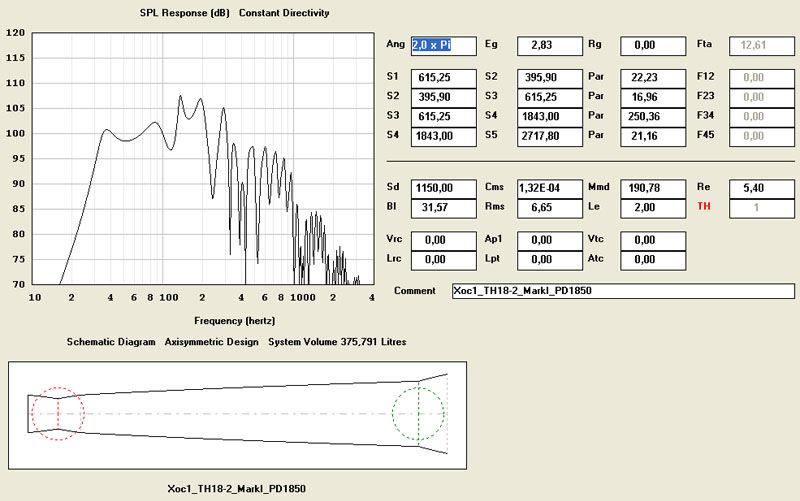
Anyway, did a Hornresp model based on a total volume 375,88 Litres of your Sketch. So S4 has become smaller to compensate for the correct total volume. Their seems to be a big difference between Akabak and HornResp in the outcome at the First System Resonance.

Hi All
Hornresp is so useful but there are always compromises that need to be made for the sim model.
Attached is one of my alternative HR sims
Volume of the unfolded horn layout is 345.7 litres not allowing for the bracing.
Volume of sim is 336 so not unrealistic - I do feel uneasy about sims that exaggerate the internal volume of a speaker cab.
Where it gets complicated is having to run 2 sims to try to understand what is happening with the various sections of the horn.
Regards
Martin
Hornresp is so useful but there are always compromises that need to be made for the sim model.
Attached is one of my alternative HR sims
Volume of the unfolded horn layout is 345.7 litres not allowing for the bracing.
Volume of sim is 336 so not unrealistic - I do feel uneasy about sims that exaggerate the internal volume of a speaker cab.
Where it gets complicated is having to run 2 sims to try to understand what is happening with the various sections of the horn.
Regards
Martin
Attachments
Hi Martin,
Another great piece of work, Posts 1010/1015
I noticed that the S1 duct height dimension 147.4mm x 535 mm internal width result in 788.59 cm^2, the Hornresp Input says 933.04 cm^2 (in the Hornresp simulation this doesn't much matter, but only one should be correct).
I think you are on the right path with using AkAbak for this one, Hornresp just doesn't seem to get us there. I tried a short L23 together with an arbitrarily choosen S4 (to get to your layout volume of 345.7 L). Looks very much like what Djim came up with?
Regards,
Another great piece of work, Posts 1010/1015
I noticed that the S1 duct height dimension 147.4mm x 535 mm internal width result in 788.59 cm^2, the Hornresp Input says 933.04 cm^2 (in the Hornresp simulation this doesn't much matter, but only one should be correct).
I think you are on the right path with using AkAbak for this one, Hornresp just doesn't seem to get us there. I tried a short L23 together with an arbitrarily choosen S4 (to get to your layout volume of 345.7 L). Looks very much like what Djim came up with?
Regards,
Attachments
Last edited:
Dynamic off-set is what mechanically damages woofers.
The Crown MA5000vz has a double-integrator (U104A, B) to try and help off-set with issues.
Some program material causes problems Power Amplifier Clipping, clipping an amplifier can cause real problems (the ESP note also discusses non-clipped program material issues).
5.2.4 Loudspeaker Offset Integration
Loudspeaker Offset Integration (LOI) circuits use double
integrating filters in the amplifier’s feedback circuitry to
protect loudspeakers in several different ways. First, they
center asymmetrical audio waveforms that cause off-center
woofer cone movement. Off-center cone movement
increases loudspeaker heating and distortion while reducing
the loudspeaker’s power handling ability. Second, LOI
filters unwanted DC and subsonic frequencies using a
third-order Butterworth filter with a 35 Hz corner
frequency. Third, LOI filters unwanted ultrasonic frequencies
(RF) that can cause tweeter burnout using a secondorder
Bessel filter with a 50 kHz corner frequency.
The Crown MA5000vz has a double-integrator (U104A, B) to try and help off-set with issues.
Some program material causes problems Power Amplifier Clipping, clipping an amplifier can cause real problems (the ESP note also discusses non-clipped program material issues).
5.2.4 Loudspeaker Offset Integration
Loudspeaker Offset Integration (LOI) circuits use double
integrating filters in the amplifier’s feedback circuitry to
protect loudspeakers in several different ways. First, they
center asymmetrical audio waveforms that cause off-center
woofer cone movement. Off-center cone movement
increases loudspeaker heating and distortion while reducing
the loudspeaker’s power handling ability. Second, LOI
filters unwanted DC and subsonic frequencies using a
third-order Butterworth filter with a 35 Hz corner
frequency. Third, LOI filters unwanted ultrasonic frequencies
(RF) that can cause tweeter burnout using a secondorder
Bessel filter with a 50 kHz corner frequency.
Hi Dan,I'm really curious as to where fudging S2 via an inflated cone correction became a good idea? The 18SW115 is really not going to make it to 60mm p-p without dammage, in fact it is hard to drive to 40mm p-p, and that's with HUGE amounts of power.
When a driver is pushed to its limits it will start producing asymmetric forces. For the suspension that is usually around the Fs of the driver, for the motor that is usually when the BL drops significant, or when the system increases the induction below the Fs of the driver. Tapped Horns and horns in general have the habit to generate all three factors.
To suppress these asymmetric forces you can do several things, Push-Pull, increasing compression at the cone (as long it is equally distributed from the centre) and using capable amplifiers like Djk already explained.
In my view, the "V" was developed for this reason just like it was used in old horns decades ago. The more capable the driver (like the B&C 18SW115 for instance) the less compensation is needed to deal with asymmetric forces. But the reality is that most people don’t have such driver and still want to be able to get the maximum out of theirs.
The "V" as used in the Xoc1-TH18-MkI is not much different as adding a restricted throat but with the convenience of allowing to increase the horn-path. Cone correction alone does not help in decreasing asymmetric forces.
- Home
- Loudspeakers
- Subwoofers
- TH-18 Flat to 35hz! (Xoc1's design)
